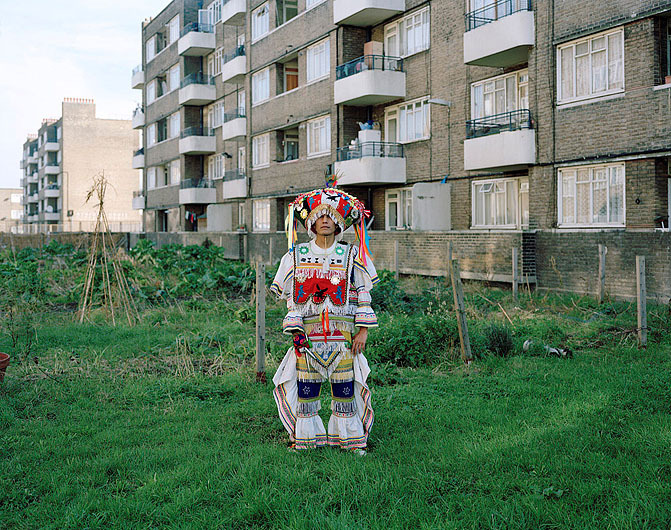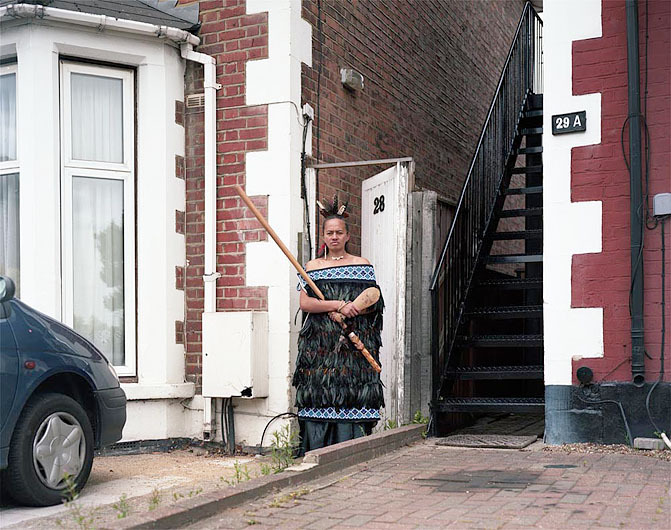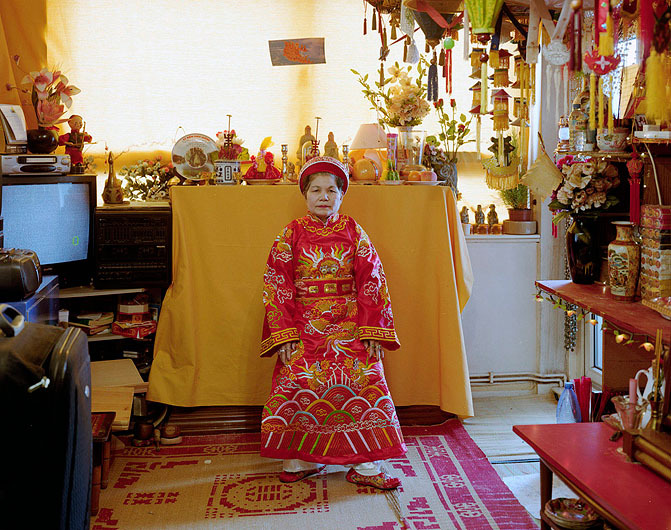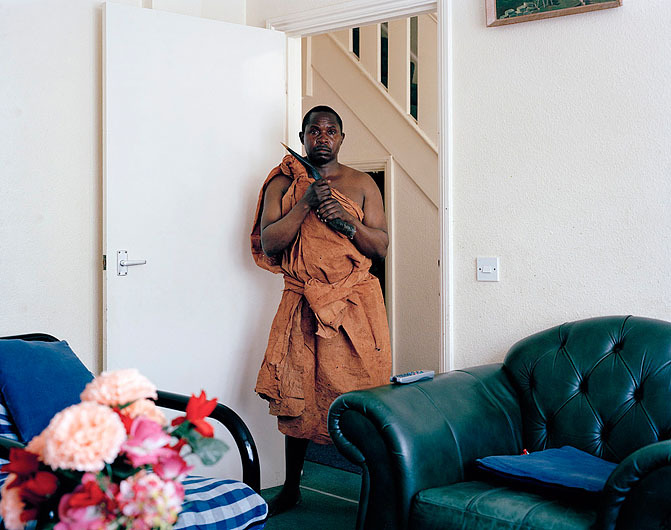Daniel Stier is a German photographer who's been living in London for around the last 15 years and still hasn't stopped finding the portly, African women in their taffetas fascinating, which inspired him to roam around London's ex-pat communities, looking for people to take photos of in their country's traditional dress. The end result, In My Country, is a set of striking images of Aztec gods in front of Hackney tower blocks and jewel-adorned, elf-like Balinese women dancing outside the drab coffee shop you buy your cup of tea from every morning.
Annons
Talking to Daniel was kind of disconcerting, making me aware of the fact that I too belong to that cliched breed of foreigner who won't stop banging on about "back home". So if you're like us (or if you just appreciate really, really good photography) you'll enjoy his photos. Here's what he said when I called him up.VICE: Hey Daniel, how's your day going?
Daniel Stier: Good, I've been doing some research for this still life project I'm working on. It's kind of hard to explain, but I'm basically building these little nature landscapes in my studio out of fake stuff I find, like plastic plants and pots and stuff.Oh, cool. Looking at the rest of your work, I guess it's fair to say you are more of an art photographer. Is that because you prefer coming up with a proper concept for a photo?
Yeah, I tend to think before I take my photos. I’m not the kind of guy who runs around with a camera all day because I prefer it when someone's really got something to say, rather than, “Oh, I’ll point my camera here and there and then maybe I'll come up with something to explain it." When it comes to art, I want to see the artist taking a clear stance.
Daniel Stier: Good, I've been doing some research for this still life project I'm working on. It's kind of hard to explain, but I'm basically building these little nature landscapes in my studio out of fake stuff I find, like plastic plants and pots and stuff.Oh, cool. Looking at the rest of your work, I guess it's fair to say you are more of an art photographer. Is that because you prefer coming up with a proper concept for a photo?
Yeah, I tend to think before I take my photos. I’m not the kind of guy who runs around with a camera all day because I prefer it when someone's really got something to say, rather than, “Oh, I’ll point my camera here and there and then maybe I'll come up with something to explain it." When it comes to art, I want to see the artist taking a clear stance.

Jose from Peru
When you're working on portraits, like the ones from In My Country, how do you prepare? How much input do your subjects have?
The way each person wants to be photographed is always fairly interesting in itself. I don’t want to have complete control, because people quite often come up with ideas I'd never have thought of – not that that can't be trying. People always have their own idea of how they'd like to pose, which can be an issue. Like, with In My Country, I tried to photograph people in their authentic environments – their street or their house, or something – and some would say "Oh, it's so ugly here, why don't I stand next to this flower?" But, you know, each side has their own ideas of what a good photograph is. Sometimes we meet in the middle, sometimes we lean to my side and sometimes it doesn't work.
The way each person wants to be photographed is always fairly interesting in itself. I don’t want to have complete control, because people quite often come up with ideas I'd never have thought of – not that that can't be trying. People always have their own idea of how they'd like to pose, which can be an issue. Like, with In My Country, I tried to photograph people in their authentic environments – their street or their house, or something – and some would say "Oh, it's so ugly here, why don't I stand next to this flower?" But, you know, each side has their own ideas of what a good photograph is. Sometimes we meet in the middle, sometimes we lean to my side and sometimes it doesn't work.
Annons
So what was the initial idea behind In My Country?
It has a lot to do with the fact that I'm German but have been living in London for the last 20 years. I love it, but I lack a sense of belonging and I'm interested in that feeling. I didn't have to come here – I'm not a refugee – so I'm not complaining, but what I tried to look at is how people integrate into a place, but don't ever fully become integrated. It's that feeling that makes London what it is; 40 percent of the people that live here weren't born in the UK.
It has a lot to do with the fact that I'm German but have been living in London for the last 20 years. I love it, but I lack a sense of belonging and I'm interested in that feeling. I didn't have to come here – I'm not a refugee – so I'm not complaining, but what I tried to look at is how people integrate into a place, but don't ever fully become integrated. It's that feeling that makes London what it is; 40 percent of the people that live here weren't born in the UK.

I'm assuming that's where the title came from?
Yeah, everyone I photographed would say stuff like “In my country” or “back home” as if they'd just left, even though they might have been living in London for 30 years. I realised I do the same thing; I've been here for so long that I have no idea what goes on in Germany nowadays, but I still refer to it as "back home".And their traditional costumes are the one part of home people can carry with them.
Yeah, exactly. For example, when you walk around parts of London, like Hackney, on a Sunday morning, you see people going to church all dressed up, and the contrast between that and the surroundings couldn't be more amazing. That's what struck me initially, so I tried to recreate it. It's all set up, but I tried to use that as a symbol for something wider.How did you find your subjects?
Oh, you find everything on the internet these days. Religious groups, churches, mosques, music groups, bands, refugee charities – every country looks after their own people, so I'd just contact those organisations. Getting them to agree to be photographed was a little harder because a lot of them deal with immigration issues, so they were suspicious that I was an immigration officer or a policeman.
Yeah, everyone I photographed would say stuff like “In my country” or “back home” as if they'd just left, even though they might have been living in London for 30 years. I realised I do the same thing; I've been here for so long that I have no idea what goes on in Germany nowadays, but I still refer to it as "back home".And their traditional costumes are the one part of home people can carry with them.
Yeah, exactly. For example, when you walk around parts of London, like Hackney, on a Sunday morning, you see people going to church all dressed up, and the contrast between that and the surroundings couldn't be more amazing. That's what struck me initially, so I tried to recreate it. It's all set up, but I tried to use that as a symbol for something wider.How did you find your subjects?
Oh, you find everything on the internet these days. Religious groups, churches, mosques, music groups, bands, refugee charities – every country looks after their own people, so I'd just contact those organisations. Getting them to agree to be photographed was a little harder because a lot of them deal with immigration issues, so they were suspicious that I was an immigration officer or a policeman.
Annons
Also, a lot of them don't speak a word of English, even after living here for 20 or 30 years. They live within their community – where they have everything they need – and the younger generation provide contact to the outside world.

Did you mostly shoot refugees or people who had chosen to come here? Does that even make a difference to the photograph?
Everything makes a difference. I guess most Europeans I shot have chosen to be here but there's quite a few refugees, and I find that a little more interesting for the photo. But you know I looked for people that actually dress like that, regardless of their reason for being here, because I was interested in the stories behind the clothes. Some of them are amazing.What's your favourite of these stories?
There's this one guy, Jose, from Peru, who's amazing. He's from a village in the Andes and does this ritual dance thing. He's one of those people who's made a real effort to settle here, but, at the same time, still has his own culture deeply rooted within him. He tries to showcase his culture every chance he gets – at schools and clubs and proms – and he's received as a sort of mythical figure when he goes back to his village.
Everything makes a difference. I guess most Europeans I shot have chosen to be here but there's quite a few refugees, and I find that a little more interesting for the photo. But you know I looked for people that actually dress like that, regardless of their reason for being here, because I was interested in the stories behind the clothes. Some of them are amazing.What's your favourite of these stories?
There's this one guy, Jose, from Peru, who's amazing. He's from a village in the Andes and does this ritual dance thing. He's one of those people who's made a real effort to settle here, but, at the same time, still has his own culture deeply rooted within him. He tries to showcase his culture every chance he gets – at schools and clubs and proms – and he's received as a sort of mythical figure when he goes back to his village.

My favourite's the one of that tiny woman in her flat.
Yeah, she's amazing, too. She's from Vietnam and lives in a council flat in Hackney. When I first visited her I witnessed this great culture clash. There was a full on East End funeral going on at the bottom of the tower block, with horses and old ladies going "Alright Darling' and all that, then I went up the lift to her flat and it was basically a shrine where people go to worship.
Yeah, she's amazing, too. She's from Vietnam and lives in a council flat in Hackney. When I first visited her I witnessed this great culture clash. There was a full on East End funeral going on at the bottom of the tower block, with horses and old ladies going "Alright Darling' and all that, then I went up the lift to her flat and it was basically a shrine where people go to worship.
Annons
She didn't speak any English, even though she's been here since the 70s, so I didn't completely understand, but I think she belongs to some kind of Vietnamese cult. People bring stuff to her and she blesses it – I had to drink a warm beer in the morning because it was blessed. There are these little Vietnamese communities all over London; you walk in and it feels like you're in Saigon.

What about the guy in the orange sheet?
He's a Ugandan refugee who used to fight as a guerrilla warrior and somehow got mixed up in the army, then somehow ended up here. The whole story was extremely sad; he couldn't speak the language, didn't speak to his neighbours and couldn't stand being here.I went to the mayor's office when I tried to find somewhere to exhibit the photos and they're all very up for promoting the idea of a multicultural London, but not the actual stories behind it. I mean, yes, London is "colourful", but the stories that come with that are often very depressing. The official London picture is not like the reality.To launch the gallery click here.In My Country is on show until October 29th at the Stour Space gallery. Admission is free so get off your ass and go have a look. Follow Elektra on Twitter: @elektrakotsoniWant more "colourful" photography?
Civil War, Cowabunga!The Grisly Dead Pictures of Fernando BritoDesk Nazis of the World Unite
He's a Ugandan refugee who used to fight as a guerrilla warrior and somehow got mixed up in the army, then somehow ended up here. The whole story was extremely sad; he couldn't speak the language, didn't speak to his neighbours and couldn't stand being here.I went to the mayor's office when I tried to find somewhere to exhibit the photos and they're all very up for promoting the idea of a multicultural London, but not the actual stories behind it. I mean, yes, London is "colourful", but the stories that come with that are often very depressing. The official London picture is not like the reality.To launch the gallery click here.In My Country is on show until October 29th at the Stour Space gallery. Admission is free so get off your ass and go have a look. Follow Elektra on Twitter: @elektrakotsoniWant more "colourful" photography?
Civil War, Cowabunga!The Grisly Dead Pictures of Fernando BritoDesk Nazis of the World Unite
